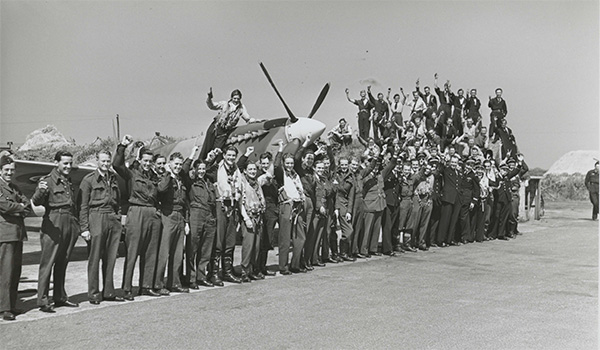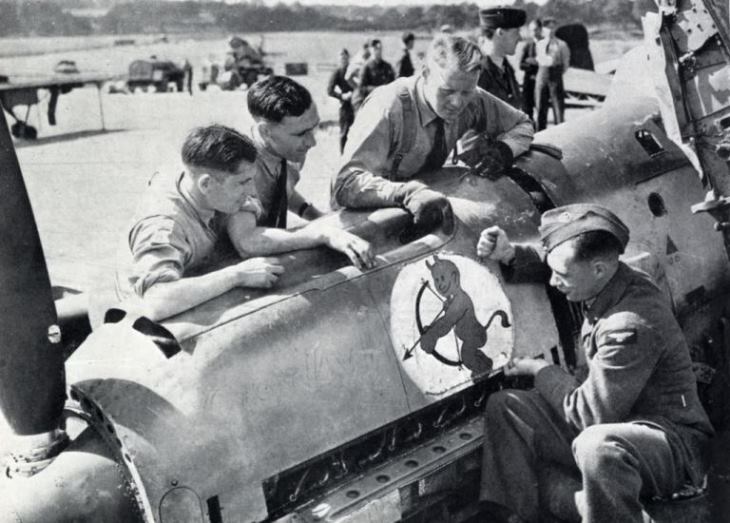Everyone knows about the Battle of Britain, and how ‘the Few’ saved the country from invasion. What they don’t necessarily remember is that every one of the fighter pilots mentioned in Churchill’s ‘the Few’ speech had a team of dedicated ground crew, RADAR operators, WAAFs and many more behind him, and that Fighter Command, however much they were feted after the war (entirely deservingly) were not the only ones mentioned in his speech on August 20th, 1940:
“The gratitude of every home in our Island, in our Empire, and indeed throughout the world, except in the abodes of the guilty, goes out to the British airmen who, undaunted by odds, unwearied in their constant challenge and mortal danger, are turning the tide of the World War by their prowess and by their devotion. Never in the field of human conflict was so much owed by so many to so few.”
“All hearts go out to the fighter pilots, whose brilliant actions we see with our own eyes day after day; but we must never forget that all the time, night after night, month after month, our bomber squadrons travel far into Germany, find their targets in the darkness by the highest navigational skill, aim their attacks, often under the heaviest fire, often with serious loss, with deliberate careful discrimination, and inflict shattering blows upon the whole of the technical and war-making structure of the Nazi power. On no part of the Royal Air Force does the weight of the war fall more heavily than on the daylight bombers, who will play an invaluable part in the case of invasion and whose unflinching zeal it has been necessary in the meanwhile on numerous occasions to restrain.”
There’s no doubt that the fighter pilots were a heroic bunch, and that the work of the ‘Aces’ did a lot to boost the morale of beleaguered Britain. Douglas Bader was, of course, particularly well-known for the fact that, despite having his legs cut off after a plane crash in 1931, he went on to gain the Distinguished Flying Cross with Bar, not to mention the Distinguished Service Order with Bar, and shoot down 23 enemy aircraft. Additionally, he was the co-creator of the ‘Big Wing’ tactics, which involved sending a strong force to intercept enemy pilots over the Channel, and once captured, escaped the clutches of the Germans so many times that they were forced to confiscate his prosthetic legs. However, as John Rawlings asserts in his ‘Fighter Squadrons of the RAF’, for every high-scoring Douglas Bader there was a much less celebrated ‘Number Two’ who shadowed and guarded the tails of the attacking planes, allowing the ‘Aces’ to do their job to the very best of their abilities.

Although Churchill mentioned the work of bombers in his speech, Bomber Command was far less lauded after the war, as the government was squeamish about praising those who had flattened the German capital and caused many civilian casualties. This was, of course, part of their allotted role in the war, but the pilots and crews did much more than bomb cities. They destroyed communications systems to hamper the efforts of German Command, as well as bombing the factories producing the very planes that would spar with the fighters over Britain and the bombs that would be dropped onto soldiers and civilians alike. Also, crucially, it was they who bombed Berlin, throwing Hitler into a rage that would cloud his judgement and lead him to direct the German bombers to stop tackling British airfields, RADAR stations and factories and instead begin bombing London. While this assault was terrible, it gave Fighter Command the chance to step off its back foot for a while, reinforce, retrain and assess their tactics, and come back stronger against the Luftwaffe; without this opportunity, Fighter Command would likely have been crushed entirely in the autumn of 1940, and Operation Sealion, the invasion of Britain, might have succeeded.
Both Fighter Command and Bomber Command would have been, literally and figuratively, completely lost without RADAR. The RAdio Detection And Ranging system acted as the the eyes and ears of the aircrew, and without the help of the operators to help them locate attacking enemy aircraft in the (very large) skies, such a small number of planes as were available in the early summer of 1940, post-Dunkirk, would never have been able to tackle the numerically superior and highly experienced Luftwaffe fighters. Air Chief Sir Hugh Marshall Dowding was able, with their help, to conserve his valuable planes and pilots, and so nurse the RAF through June and July until more planes could be produced. Nor were the workers on the ground necessarily safer than the men in the air, as RADAR stations were targets, and the brave operators often refused to abandon their posts, even in the midst of the very heaviest bombing. Later in the Battle of Britain the role of RADAR became even more critical, as the Germans began night bombing. As the introduction of ‘The WAAF in Action’ explains, “The radiolocation system of warning is very desirable in aerial warfare by day, but for aerial warfare at night it is absolutely essential.”

The WAAF in particular took on this sort of role, as well as many other jobs around the airfields, men being thin on the ground during the war, and the book adds, “The WAAF telephonist and the WAAF cook were to be at a post as dangerous as the outpost of an infantry front line.” The women not only worked in the Operations Rooms and Signals Rooms, but as drivers, orderlies, riggers, fitters, electricians, and were often tasked with maintaining Barrage Balloons. The book quotes a Group Captain as saying, “As an officer of 26 years’ service, I sincerely believed that war was not a job for a women. In war, women could tackle the more quiet and comfortable jobs, and leave it to the fathers and brothers and cousins to fill the fighting services.” However, the same Group Captain, after working in the company of the women throughout the Battle of Britain, later admitted, “I have cause to thank goodness that this country can produce such a race of women as the WAAF of my station.”
Another essential element of the RAF was the largely unsung ground crew. Whenever the pilots were in the air, the ground crew were also hard at work, directing battered aircraft in to land and patching them up so that they were fit to fly, fuelling and servicing the planes, and ensuring that the guns were in tip-top working order. The Royal Air Force Benevolent Fund recently posted an interview with veteran Stan Harthill, and he said, “The ground crew felt we had a very important part to play in the Battle of Britain because our job was to keep the Spits flying, and without the Spits the pilots were of course useless.”
How true… a pilot is nothing without his plane, which leads us to one final lot of unsung heroes, the designers and factory workers who built the Spitfires and Hurricanes used to defend Britain (as well, of course, as the Lancasters). Thanks to the efforts of Lord Beaverbrook and these excellent workers, our output of planes far outstripped that of Germany, and as Norman Ferguson attests in his ‘The Second World War: a Miscellany’, in June 1940 we produced 446 new aircraft to Germany’s 220.
So, on the Anniversaries of the Battle of Britain, we say thanks not so much to ‘the Few’ as to ‘the Many’ who kept Britain safe and free in 1940 and foiled Operation Sealion. If you want to learn more about the people who have especial reason to thank all these brave souls, those on the ‘Most Wanted’ list of Hitler’s Black Book, intended for immediate arrest on invasion, read more HERE

